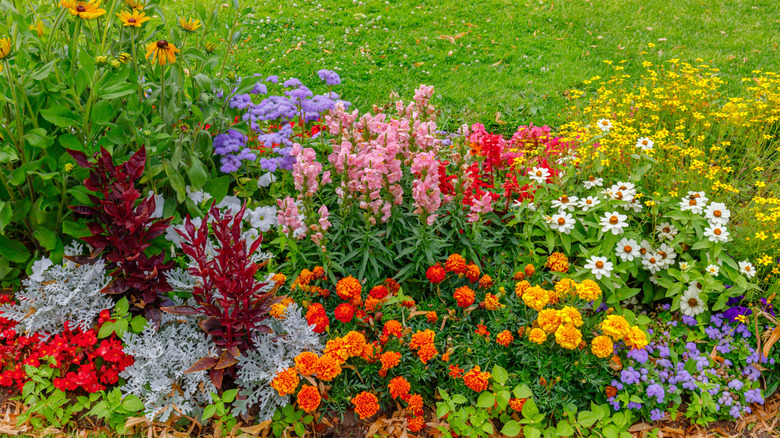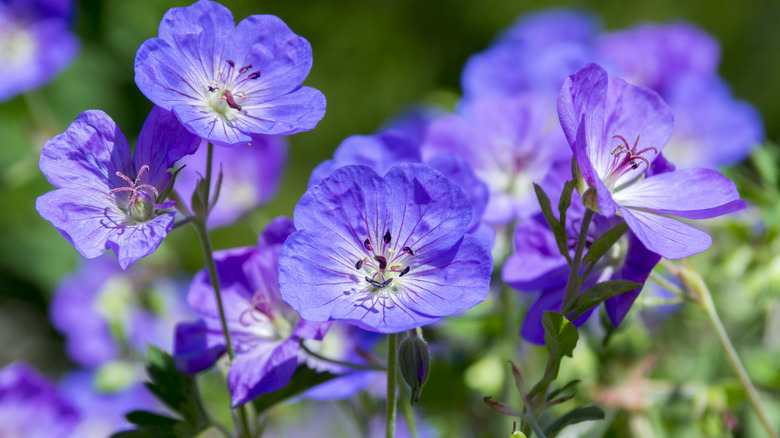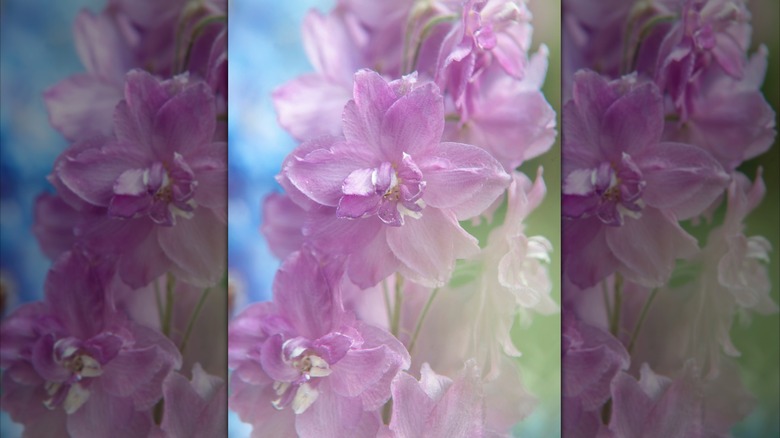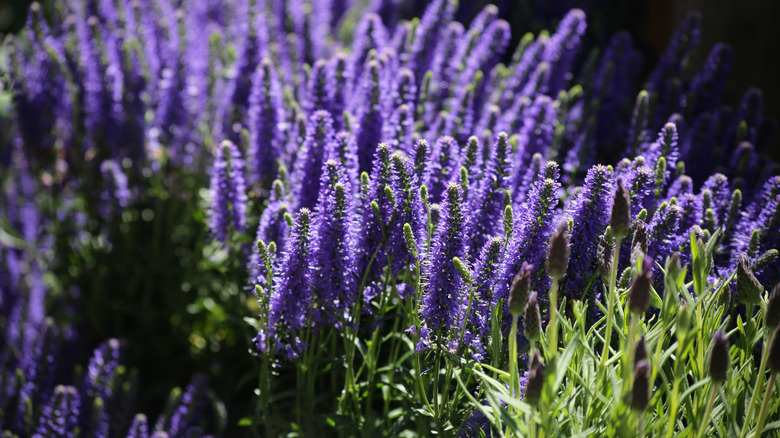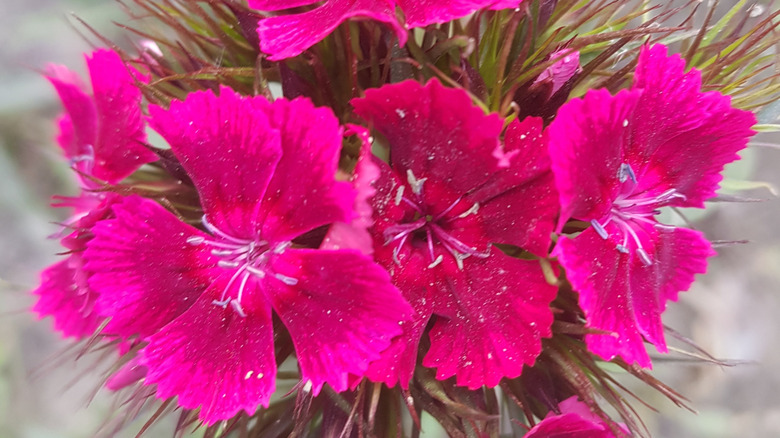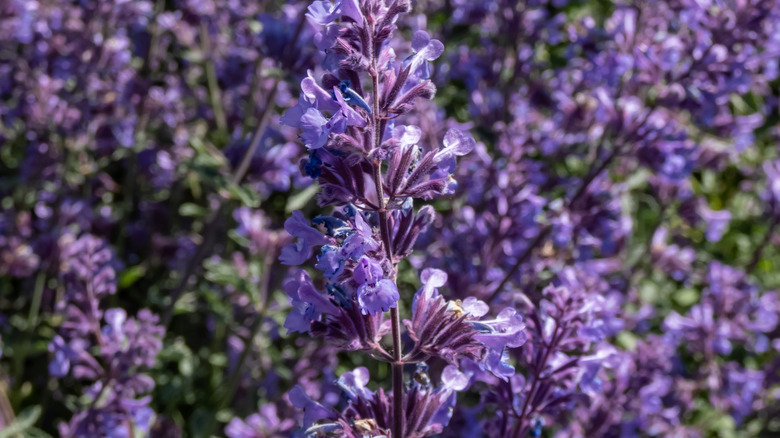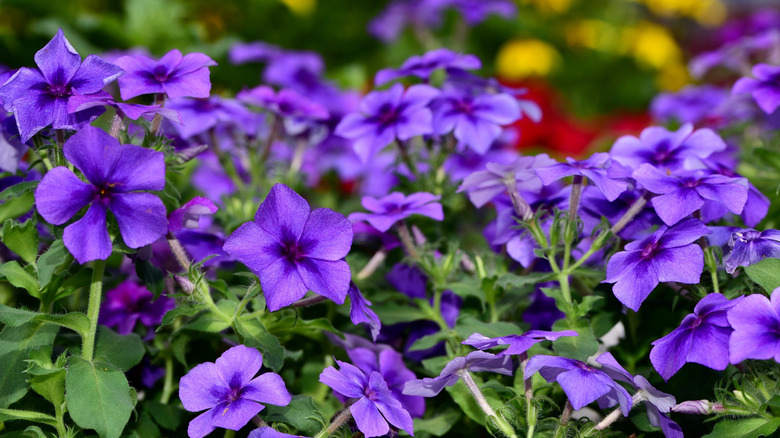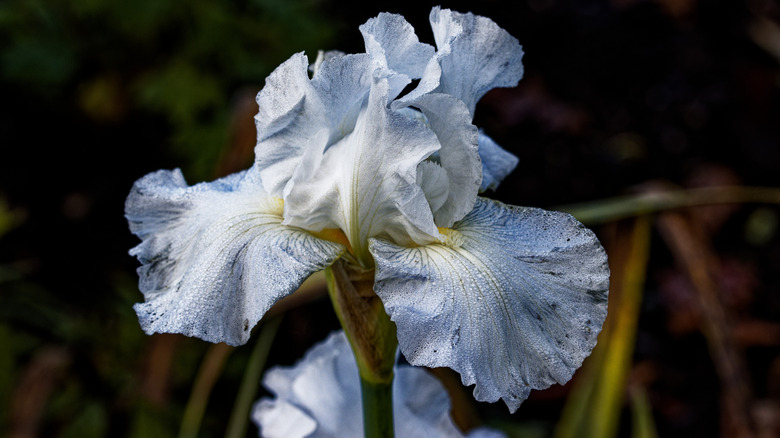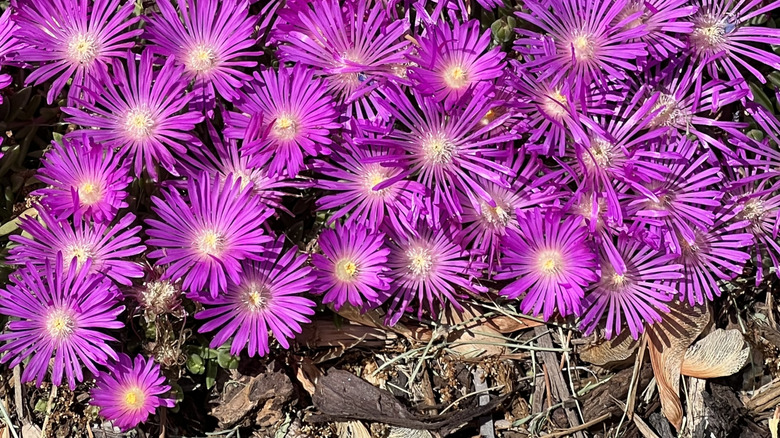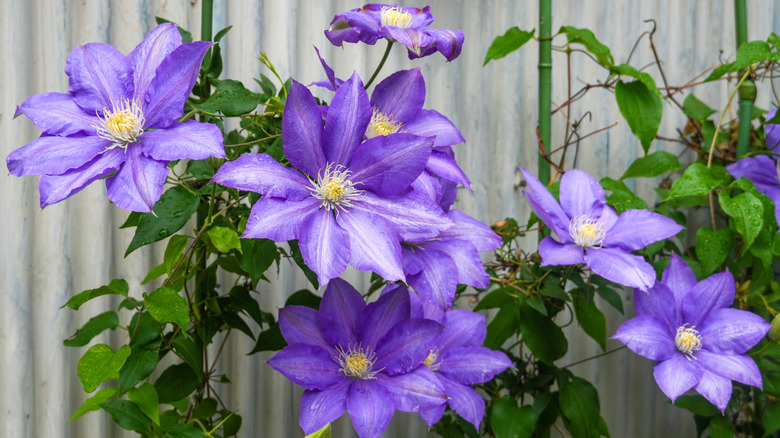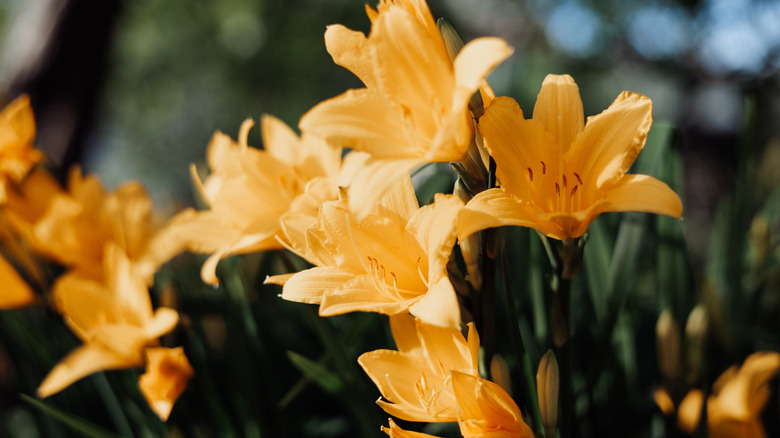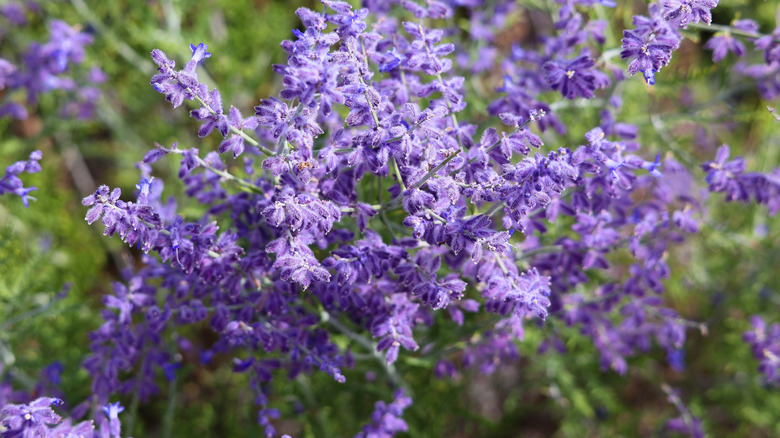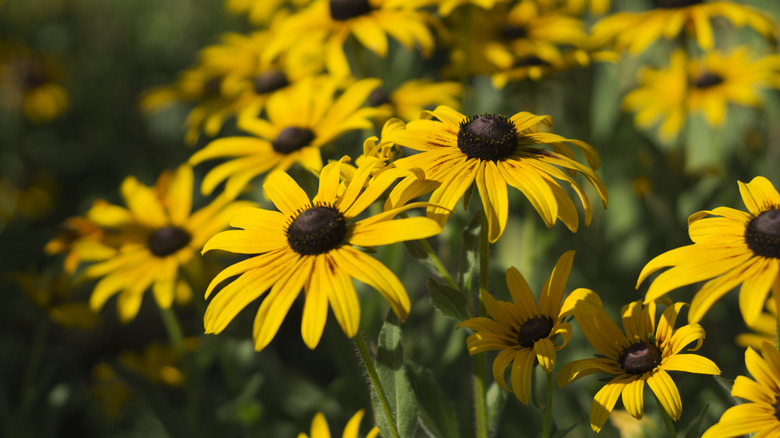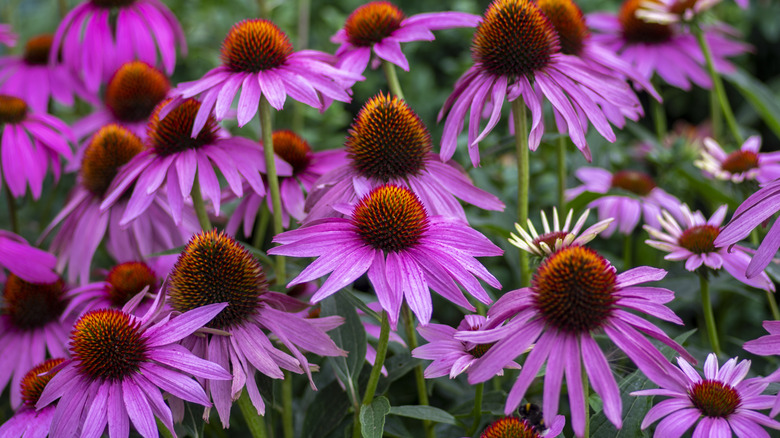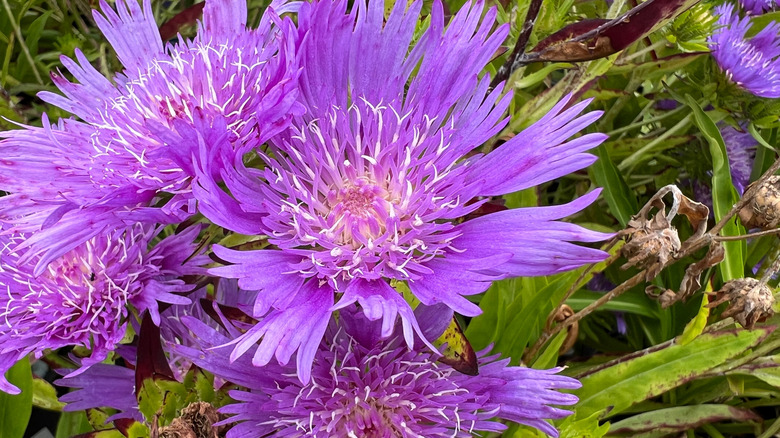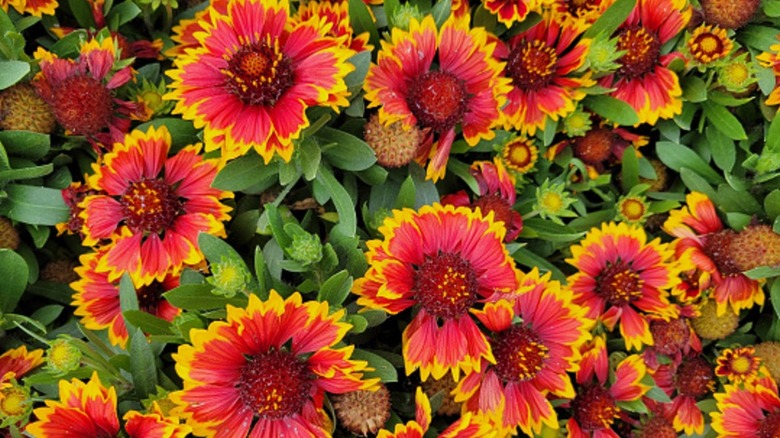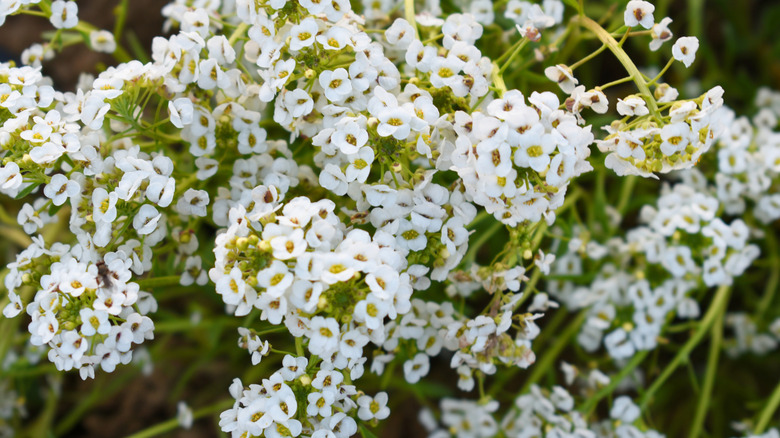17 Perennials That Bloom More Than Once For A Colorful Garden Year-Round
We may receive a commission on purchases made from links.
Having a garden that's in bloom year-round is the dream — if only it were simple to accomplish. While you could certainly pop seasonal annuals in the beds, the cost and the effort quickly add up. To keep things manageable, it makes sense to turn to perennials, which dependably return each year and can be divided every few seasons for more plants.
When constant color is the priority and real estate is at a premium, you need to pay attention to flowering times. After all, not all perennials bloom for extended periods. For instance, tulips mostly last between one and three weeks in the garden, leaving bare greenery in their wake afterward. In contrast, reblooming varieties of bearded iris, clematis, or daylilies transform your garden into a vibrant tapestry for months on end. All in all, to maintain a colorful garden year-round, it's best to grow perennials that deliver wave after wave of blooms throughout the year. Geranium, phlox, catmint, ice plant, salvia, coneflower, tickseed, blanket flower, and many other perennials are some such examples, as you'll discover shortly.
Rozanne geranium
With white eyes, violet petals, marbled foliage, and a sway on butterflies, you could argue these are reasons aplenty to grow 'Rozanne' Geranium (Geranium 'Rozanne'). Better yet, they have an exceptionally long season. In hot climates, they begin producing gorgeous blooms in late spring, reblooming in flushes until frost. Should the hot summer outdo their built-in heat resistance, cutting back the plant encourages new flowers in the fall. Even if you live in cool climates — 'Rozanne' geranium is hardy in zones from 5 to 8 — you can expect blooms in summer and fall. Mass plant them in a sunny or partially shaded spot.
'New Millennium' delphinium
'New Millennium' delphiniums (Delphinium elatum 'New Millennium'), also known as 'New Zealand Stars', are another suitable choice for extended color. This hybridized cultivar produces its first wave of flower spires in early summer. After you remove the discoloring spires, they'll reward you with another wave in early fall. These perennials are available in a rainbow of colors, including blue, pink, and purple, and are often sold as multi-colored mixes in the United States. You can mass them in borders to benefit from deer and rabbit resistance. They can grow up to 6 feet tall and are hardy in zones 3 to 7.
Caradonna salvia
If you're looking to add vertical interest and maintain it for the greater part of the year (May to September), 'Caradonna' salvia (Salvia nemorosa 'Caradonna') can be an exciting addition in zones 3 to 8. Around late spring, 2-foot-tall purple stems smothered in violet petals pop out from their low-growing mound, attracting butterflies. Removing the dead blooms and generous watering will keep the show going throughout the summer. Or, you could shear the dead stems down to basal foliage for a fall flush. Moist soils in full sun exposure are preferred, though the plants adapt to dry soils. Deer won't bother with this perennial.
First Love hybrid pinks
Unlike old-fashioned pinks, their hybrid counterparts like 'First Love' (Dianthus 'First Love') enjoy a long blooming season. Hardy in zones 4 through 9, they'll be in bloom from spring through frost (April to September) in colder regions. Down south, they may bloom throughout the year. To ensure continual blooms, though, you must deadhead them regularly. What makes 'First Love' a true standout is that at any time it sports multiple hues, as the emerging white flowers grow pink, then lavender, with age. These short-lived, evergreen perennials require six hours of direct sunlight and well-draining soil.
Walker's Low catmint
'Walker's Low' catmint (Nepeta x faassenii 'Walker's Low') may not be as popular with household cats as other catmint varieties. But it's a worthy addition for multi-season interest and to attract pollinators, including bees and hummingbirds, in zones 4 to 8. Planted in the right conditions, like full sun and rocky soils, 'Walker's Low' will produce dainty, lavender-blue blooms as the summer begins. If you keep deadheading the spent blooms, their show will last into the fall. However, when it gets too hot, you may need to provide them with afternoon shade. Another bonus? These easy-to-grow ground covers can smother weeds in your yard and garden.
Hybrid phlox
Certain hybrid phlox collections, such as Opening Act and Fashionably Early, start blooming two weeks ahead of the standard phlox varieties in early summer. By shearing off the spent blooms, you can stimulate the plant to rebloom in fall. Most cultivars from these series produce white or violet flowers and can grow about 3 feet tall, making them appropriate as mid-level plantings. Since they showcase resistance to powdery mildew, you can depend on these plants to look reliably beautiful throughout the growing season. They'll need a sunny or a lightly shaded site in zones 5 through 8.
Reblooming bearded iris
Remontant, or reblooming, bearded irises like 'Eternal Bliss', 'Violet Music', and 'Plum Wine', kick into action in spring and produce multiple flushes in summer and fall — sometimes more if the weather is sufficiently warm and dry. This also implies that their reblooming will take a hit if they're sited in wet, humid regions, as is common to Florida and the Gulf Coast. Most varieties are hardy in zones 5 to 10, though certain cultivars have been bred to be more cold-resilient. 'Immortality,' a beautiful variety of white iris flower, is one such example for zone 3. You'll need to water and fertilize them more frequently for additional blooms.
Hardy ice plant
Hailing from South Africa, hardy ice plant (Delosperma cooperi) is another perennial you may consider growing for a colorful garden in zones 6 through 10. From June to September, their speckled foliage is topped by neon pink or purple blooms. Spreading 24 inches wide but growing no taller than 3 inches, these drought and weed-resistant succulent ground covers will give your yard a pop of color. Although considered evergreen, they may die back in the winter in zones 7 and north. Hardy ice plants enjoy full sun exposure and dry, sandy or gravel soils. They resist deer herbivory.
Clematis
As a genus with over 250 species and cultivars, clematis is divided into three distinct groups. Out of these, Group 2 are repeat bloomers, providing an additional flower flush. Since they produce buds both on old and new wood, you'll first experience their flowers in late spring or early summer, assuming they weren't damaged in the winter. A second cycle will follow by summer's end. To improve flowering, lightly prune the plant after the first flush. 'Cardinal Wyszynski', 'Vyvyan Pennell', and 'The President' are popular options. Clematis is hardy in zones 3 to 9. Be sure to check if your chosen variety is invasive in your area before planting it.
Reblooming daylilies
Their flowers may not last beyond a day, but certain daylily (Hemerocallis spp.) varieties can remain in bloom for at least 10 weeks. This could either be chalked up to a flower scape holding many buds or the plant producing multiple scapes. Either way, depending on the rebloomer, you can expect non-stop blooms or a small pause between spring to fall flushes in zones 3 to 9. Nice options include 'Stella de Oro', 'Big Time Happy', 'Happy Returns', 'Raspberry Frolic', 'All American Chief', and 'Pardon Me'. Like clematis, certain daylily varieties can be invasive, so confirm before planting them.
Tickseed
Many tickseed (Coreopsis spp.) varieties, including C. grandiflora, C. verticillata, and C. tinctoria, can be induced to produce another surge of flowers if you deadhead them throughout the growing season. This will also put a lid on their self-seeding tendencies, preventing any undesired takeover. Choose options native to your region to benefit the local pollinators. Tickseeds require average soils and full sun. If your garden is in the line of high winds, stick to dwarf varieties or be prepared to put down stakes to prevent the perennials from flopping down. You'll need to separate their clumps every four years. It's typically hardy in zone 4 to 9, though it may vary across the species.
Russian sage
Love the blooms on lavender but can't grow it successfully in your yard? Grow Russian sage (Salvia yangii, previously Perovskia atriplicifolia) instead and enjoy the similar-looking purple spikes from late spring through frost in zone 4 to 9. Once Russian sage establishes in your yard, it's fairly low maintenance, especially with the drought resilience kicking in. Place in a sunny, well-draining site and experience the perennial grow about 5 feet high. You must prune these plants in spring to keep them happy and healthy, as deer are unlikely to take an interest in trimming them down. Hummingbirds, butterflies, and bees visit their flowers.
Black-eyed Susan
Aptly named, black-eyed Susan (Rudbeckia hirta) plants produce daisy-esque flowers in the classic taxi yellow hues with nectar-rich black centers that are quite popular with bees, butterflies, and moths. Regular deadheading will encourage the plants to extend their flowering season from summer until a hard frost (usually July to October). This will also limit volunteer seedlings, though you may want to spare a few toward the end for birds. In zones 3 through 8, grow black-eyed Susans in moist soils with full sun exposure.
Coneflower
You can rely on coneflowers (Echinacea spp.) to brighten up and bring in butterflies to your garden with their purple, pink, or yellow petals on display from mid-summer through fall. Just locate them in a sunny site, from zones 3 to 9, holding moist soils with proper drainage so they can grow vigorously. To maximize wildlife value, plant varieties native to your area, and leave some spent blooms on toward the season's end so the finches can enjoy the seeds during the winter. Coneflowers can grow about 4 feet tall and half as wide. Being drought-resistant, they're suitable for waterwise landscapes.
Stokes' aster
Stokes' aster (Stokesia laevis) is an easy-to-care-for, herbaceous perennial native to the southeast United States. From spring onwards, they explode in pin-cushioned lilac-blue flowers that can be as wide as 4 inches. This display usually lasts through July, but if you snip off the spent blooms, you can expect to enjoy their blooms for longer, sometimes well into early fall. Pair these plants with warm-colored flowers like black-eyed Susan, and watch bumblebees and butterflies go wild with ecstasy. Several white ('Silver Moon'), yellow ('Mary Gregory'), and pink-blooming ('Rosea') cultivars are available. Save for hot climates where afternoon shade is necessary, grow them in full sun in zones 5 to 9.
Blanket flower
Blanket flowers (Gaillardia spp.) are a great choice for informal gardens. From spring to frost, these perennials will regale you with daisy-like flowers that bloom in variegated tones of yellow, orange, and red. Be sure to deadhead them regularly for the best display. Pollinators, especially bees and butterflies, are instantly drawn to their blooms, though deer and rabbits tend to avoid them. Blanket flowers are at home in zones 3 to 9. Since they can withstand extreme heat, drought, and salt, they can be suitable around challenging sites, as long as they receive ample sunlight. Handle carefully to prevent contact dermatitis.
Sweet alyssum
Annuals in cool climates, sweet alyssums (Lobularia maritima) can be grown as perennials in zones 9 to 11. These low-growing plants will carpet your ground in honey-smelling, white flowers in the spring. If the summers are not too hot, you can enjoy this view continuously until fall or year-round if you live in a frost-free area. In case the flowering quality declines in the summer, trim the foliage to the ground to rejuvenate it. Sweet alyssum grows best with dappled afternoon sun and excellent drainage. Mass them in beds, so the abutting ornamentals can benefit from the good bugs they attract.
